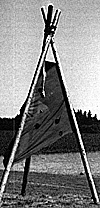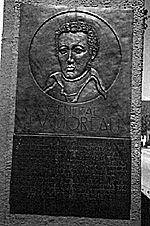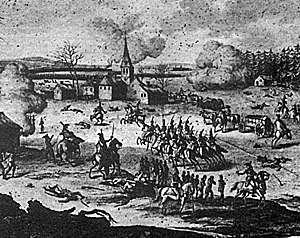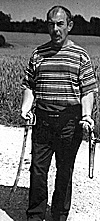Hohenlinden 2000
Battlefield Tour
by Paul Ridgley, UK
| |
So, about a week into our holiday, Josef announced that he had made arrangements for us to visit Hohenlinden and early the next morning we set off. Hohenlinden is a small town about 38 kilometres from Munich airport on the B12 Muhldorf road and is situated in beautiful countryside.
I took with me all the information I had on the battle including a battle plan I had in a publication. As we approached Hohenlinden from the east on the B12 we could see in the middle of a field on our right hand side what appeared to be an Indian tepee.
Josef stopped the car and we walked over to the tepee. He told us this was the Hohenlinden monument. A small sign pinned on a board by the roadside explained that the three timber legs of the tepee commemorated the armies of Austria, Bavaria and France. The ten red ribbons hanging from the top of the structure indicated the 10,000 dead from the battle and the green canvas around the legs represented the tunics of the soldiers complete with musket ball holes. Not too enthralled, we drove on into the town.
The Town
On the 200th anniversary in December 2000 there would be a number of events held in the town and a dedication of a proper monument to the armies that took part. It is also hoped that a museum be built to house battle relics and give information to the visitors about the layout of the opposing armies and their movements. A 50-page booklet has already been produced, full of information. Sadly for me it is only written in German. A commemorative bronze medal had also been produced, proceeds from this and the booklet assisting towards the monument and museum.
We then met the two mainstays of the organising committee, Alfons Naal and Rudolph Schierl. They were pleased to show us more relics of the battle that they had collected as well as a selection of old lithographs and paintings. They also showed us the proposed site for the battle monument.
Tour
We were invited to tour the battlefields area by car, a chance I was not going to miss. We started off in the town of Hohenlinden, returning to the GASTHOF where we had already seen Moreau's plaque. Inside the foyer of the GASTHOF there is a copy of the Austrian casualty list naming the dead, wounded and missing from the battle. On the other side of the road is a row of shops, and there, barely visible unless you know where to look, is a commemorative stone set in the wall above one of the shop windows.
We then visited the pharmacy where we were shown (believe it or not) a large print of the battle which covers one whole wall of the stock area. The pharmacist also had a very good quality early print of the battle which he was pleased to show us. Surprisingly, the town church, which is older than 1800 has no plates, plaques or mementoes relating to the battle.
We continued our tour out of the town. I proudly showed my battle plan in my book. Rudolph and Alfons burst out laughing. It was wrong by 90 degrees. A well known Napoleonic author had not got his facts right.
Bearing in mind the French army had been in the area for some time before the battle, it was no surprise to find General Moreau Strasse in Mittbach, a small village northeast of Hohenlinden. Here is the house of the tailor who made clothes for Moreau during his time there.
This whole area around Mittbach was in the hands of the Austrians during the battle, but surprisingly I was told they took no part in the action.
We drove on to the town of Kronacher, north of Hohenlinden and were met by the local historian. She was able to explain the events that took place here, and she took us to the church of St. John, which was occupied by the French as an observation post during the battle. The original steeple was hit by canon fire and collapsed and an 'onion' dome now surmounts the building. As you enter the church yard by the front gate, if you look up to the left wall of the church you will see a canon ball embedded in the stonework below the eaves.
A painting of the battle can be found inside the church donated by Steven Stocka. He was captured by the French and charged with spying but luckily he escaped and hid in a ruined stone hut until the French moved off after the battle.
We then visited the Haager forest where French regiments encircled the Austro-Bavarian army and by doing so caused the decisive damage which turned the battle in favour of the French. Our guides told us that it was a fact that the French, who had cantoned in the area for some time and knew the area very well, had made a positive operational manoeuvre to out flank their opponents. It most certainly was not, as detailed in my British books, a wandering detachment aimlessly meandering around and luckily finding the rear of the enemy that turned the tide that day. Once again, it seemed that information I had relied on was wrong.
Movements
After the battle, the wounded of the Austrian Bavarian army along with a number of wounded French prisoners travelled along the old post route of the B304 to Baumberg. The defeated armies retreated by way of Muhldorf and the main body continued on to the massive fortress of Burghausen on the Austro-Bavarian border, arriving on the 5th December. The French advanced along the B12 via Trostberg before arriving at Burghausen on the 7th December. On 15th December the Austro-Bavarian army surrendered to General Ney.
At Baumberg monastery, the 2,000 wounded being tended by the monks contracted typhus. The epidemic wiped out virtually all of them. A monument has been erected to their memory in the Military Cemetery just below the monastery. To visit Baumberg, travel to Altenmarkt, via Trostberg on the B304, and turn right in the town after the sweeping bend and traffic lights.
Each year in June, a remembrance service is held at Baumberg for the fallen of Hohenlinden, the 1870-71 war and the two World Wars. When we visited the cemetery, the Hohenlinden monument and all the graves also had a bunch of flowers and a remembrance candle. At the entrance to the cemetery, the flags of Bavaria, Austria and France were flying in remembrance.
The Burgermeister at Hohenlinden, and our two guides asked me to inform First Empire readers of their venture for 2000. They would welcome any artefacts, drawings or information on the battle, and they would certainly welcome most wholeheartedly the attendance of any re-enactment groups during their celebrations. If you wish to personally assist in their venture, or just have a memento of the 200th anniversary, send for information to: Verein Howenlinden 2000, Herrn Alfons Nagl, Vorsitzender
Steinstrasse 4, 85664 Hohenlinden Germany
At right, Ridgley with relics recovered from the site.
Before I finish this article, I would like to thank my friend Josef for organising the day, and of course Burgermeister Ludwig and our two guides Alfons and Rudolph who were so patient with my many questions, and of course my wife, Tania, for taking the photographs and following me around another Napoleonic battlefield without too much of a grumble (only kidding, dear!)
Finally, during our visit I was given a copy of a poem which was written by Thomas Campbell, a British eyewitness to the battle, and it was published in 1802. It reads thus:
On Linden, when the sun was low.
But Linden saw another
sight By torch and trumpet fast
arrayed, Then shook the hills with thunder
riven, But redder yet that light
shall glow 'Tis morn, but scarce yon level sun
The combat deepens. On, ye brave,
Few, few shall part where many
meet! Thomas Campbell, Publication Date:
1802
The Hohenlinden Memorial (FE#54)
|
 In June last year, my wife and I visited Bavaria and stayed with a long-term pen friend, Josef, in the town of Trostberg. Before we left I wrote to Josef and asked if he would mind us visiting the Hohenlinden battlefield area during our stay.
In June last year, my wife and I visited Bavaria and stayed with a long-term pen friend, Josef, in the town of Trostberg. Before we left I wrote to Josef and asked if he would mind us visiting the Hohenlinden battlefield area during our stay.
 Josef first took us to the town centre where all we could find commemorating the battle was a plaque on the GASTOF dedicated to General Moreau. We then went to the town council offices and here we met the BURGERMEISTER, LUDWIG MAURER. The town council had some weapons and a canon ball in its archives which we were allowed to handle and they also had a few paintings of the battle, which were interesting. Ludwig explained that nothing had ever been done by the local community to commemorate this important battle. However, this was going to change.
Josef first took us to the town centre where all we could find commemorating the battle was a plaque on the GASTOF dedicated to General Moreau. We then went to the town council offices and here we met the BURGERMEISTER, LUDWIG MAURER. The town council had some weapons and a canon ball in its archives which we were allowed to handle and they also had a few paintings of the battle, which were interesting. Ludwig explained that nothing had ever been done by the local community to commemorate this important battle. However, this was going to change.
 Our guides were well versed on the movements of the armies and they had many stories to tell including that of the Austrian Grand Duke (only 18 years old) who would not listen to the advice of his Bavarian General and fell into the French trap and the supposed fate of the Austrian gold which was lost during the retreat. In Budgrein a local farmer became very rich after the battle but nobody knew why.
Our guides were well versed on the movements of the armies and they had many stories to tell including that of the Austrian Grand Duke (only 18 years old) who would not listen to the advice of his Bavarian General and fell into the French trap and the supposed fate of the Austrian gold which was lost during the retreat. In Budgrein a local farmer became very rich after the battle but nobody knew why.
 The bronze commemorative medal costs 20DM (about £7) plus postage, and the booklet is, I believe, the same price. This small band of enthusiasts has an enormous amount of work to do for their venture to become a success. If you feel that this important battle is worth commemorating, as they do then I ask you to support them in any way you can.
The bronze commemorative medal costs 20DM (about £7) plus postage, and the booklet is, I believe, the same price. This small band of enthusiasts has an enormous amount of work to do for their venture to become a success. If you feel that this important battle is worth commemorating, as they do then I ask you to support them in any way you can.